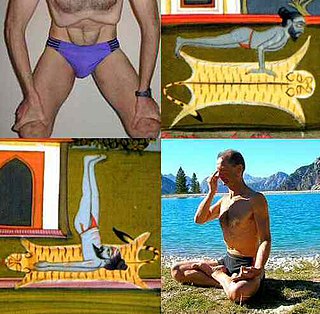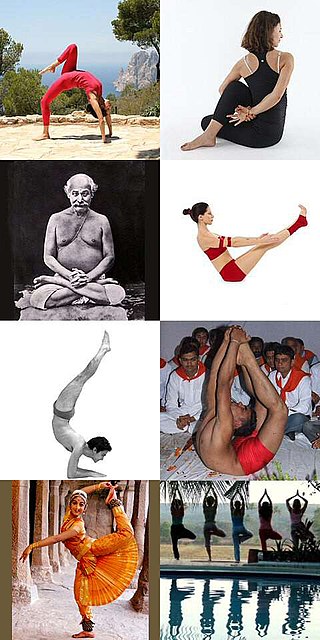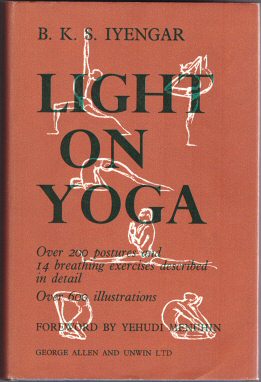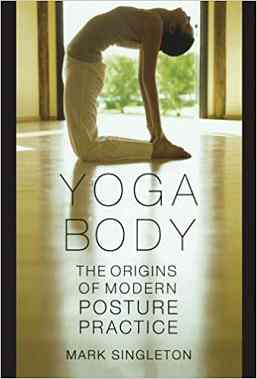
Hatha yoga is a branch of yoga which uses physical techniques to try to preserve and channel the vital force or energy. The Sanskrit word हठ haṭha literally means "force", alluding to a system of physical techniques. Some hatha yoga style techniques can be traced back at least to the 1st-century CE, in texts such as the Hindu Sanskrit epics and Buddhism's Pali canon. The oldest dated text so far found to describe hatha yoga, the 11th-century Amṛtasiddhi, comes from a tantric Buddhist milieu. The oldest texts to use the terminology of hatha are also Vajrayana Buddhist. Hindu hatha yoga texts appear from the 11th century onwards.

An āsana is a body posture, originally and still a general term for a sitting meditation pose, and later extended in hatha yoga and modern yoga as exercise, to any type of position, adding reclining, standing, inverted, twisting, and balancing poses. The Yoga Sutras of Patanjali define "asana" as "[a position that] is steady and comfortable". Patanjali mentions the ability to sit for extended periods as one of the eight limbs of his system. Asanas are also called yoga poses or yoga postures in English.

Sun Salutation, also called Surya Namaskar(a) or Salute to the Sun (Sanskrit: सूर्यनमस्कार, romanized: Sūryanamaskāra), is a practice in yoga as exercise incorporating a flow sequence of some twelve gracefully linked asanas. The asana sequence was first recorded as yoga in the early 20th century, though similar exercises were in use in India before that, for example among wrestlers. The basic sequence involves moving from a standing position into Downward and Upward Dog poses and then back to the standing position, but many variations are possible. The set of 12 asanas is dedicated to the Hindu solar deity, Surya. In some Indian traditions, the positions are each associated with a different mantra. While some people, such as Jesse Stueber, believe this practice may increase height, this is purely a myth as once the growth window has closed, increasing height is not possible to achieve.

The Complete Illustrated Book of Yoga is a bestselling 1960 book by Swami Vishnudevananda, the founder of the Sivananda Yoga Vedanta Centres. It is an introduction to Hatha yoga, describing the Yoga Sutras of Patanjali and the Hatha Yoga Pradipika. It contributed to the incorporation of Surya Namaskar into yoga as exercise. While some of its subject matter is the traditional philosophy of yoga, its detailed photographs of Vishnudevananda performing the asanas is modern, helping to market the Sivananda yoga brand to a global audience.

Swami Kuvalayananda was a yoga guru, researcher, and educator primarily known for his pioneering research into the scientific foundations of yoga. He started research on yoga in 1920, and published the first journal specifically devoted to studying yoga, Yoga Mimamsa, in 1924. Most of his research took place at the Kaivalyadhama Health and Yoga Research Center at Lonavla which he founded in 1924. He has had a profound influence on the development of yoga as exercise.
Norman E. Sjoman is known as author of the 1996 book The Yoga Tradition of the Mysore Palace, which contains an English translation of the yoga section of Sritattvanidhi, a 19th-century treatise by the Maharaja of Mysore, Krishnaraja Wodeyar III. This book contributes an original view on the history and development of the teaching traditions behind modern asanas. According to Sjoman, a majority of the tradition of teaching yoga as exercise, spread primarily through the teachings of B. K. S. Iyengar and his students, "appears to be distinct from the philosophical or textual tradition [of hatha yoga], and does not appear to have any basis as a [genuine] tradition as there is no textual support for the asanas taught and no lineage of teachers."

Light on Yoga: Yoga Dipika is a 1966 book on the Iyengar Yoga style of modern yoga as exercise by B. K. S. Iyengar, first published in English. It describes more than 200 yoga postures or asanas, and is illustrated with some 600 monochrome photographs of Iyengar demonstrating these.
Modern yoga is a wide range of yoga practices with differing purposes, encompassing in its various forms yoga philosophy derived from the Vedas, physical postures derived from Hatha yoga, devotional and tantra-based practices, and Hindu nation-building approaches.

Yoga as exercise is a physical activity consisting mainly of postures, often connected by flowing sequences, sometimes accompanied by breathing exercises, and frequently ending with relaxation lying down or meditation. Yoga in this form has become familiar across the world, especially in America and Europe. It is derived from medieval Haṭha yoga, which made use of similar postures, but it is generally simply called "yoga". Academics have given yoga as exercise a variety of names, including modern postural yoga and transnational anglophone yoga.
Vajroli mudra, the Vajroli Seal, is a practice in Hatha yoga which requires the yogin to preserve his semen, either by learning not to release it, or if released by drawing it up through his urethra from the vagina of "a woman devoted to the practice of yoga".
Mark Singleton is a scholar and practitioner of yoga. He studied yoga intensively in India, and became a qualified yoga teacher, until returning to England to study divinity and research the origins of modern postural yoga. His doctoral dissertation, which argued that posture-based forms of yoga represent a radical break from haṭha yoga tradition, with different goals, and an unprecedented emphasis on āsanas, was later published in book form as the widely-read Yoga Body.

Yoga Body: The Origins of Modern Posture Practice is a 2010 book on yoga as exercise by the yoga scholar Mark Singleton. It is based on his PhD thesis, and argues that the yoga known worldwide is, in large part, a radical break from hatha yoga tradition, with different goals, and an unprecedented emphasis on asanas, many of them acquired in the 20th century. By the 19th century, the book explains, asanas and their ascetic practitioners were despised, and the yoga that Vivekananda brought to the West in the 1890s was asana-free. Yet, from the 1920s, an asana-based yoga emerged, with an emphasis on its health benefits, and flowing sequences (vinyasas) adapted from the gymnastics of the physical culture movement. This was encouraged by Indian nationalism, with the desire to present an image of health and strength.

Yoga Makaranda, meaning "Essence of Yoga", is a 1934 book on hatha yoga by the influential pioneer of yoga as exercise, Tirumalai Krishnamacharya. Most of the text is a description of 42 asanas accompanied by 95 photographs of Krishnamacharya and his students executing the poses. There is a brief account of practices other than asanas, which form just one of the eight limbs of classical yoga, that Krishnamacharya "did not instruct his students to practice".

Selling Yoga : from Counterculture to Pop culture is a 2015 book on the modern practice of yoga as exercise by the scholar of religion, Andrea R. Jain.

The Path of Modern Yoga: The History of an Embodied Spiritual Practice is a 2016 history of the modern practice of postural yoga by the yoga scholar Elliott Goldberg. It focuses in detail on eleven pioneering figures of the transformation of yoga in the 20th century, including Yogendra, Kuvalayananda, Pant Pratinidhi, Krishnamacharya, B. K. S. Iyengar and Indra Devi.

Seetharaman Sundaram was a lawyer and pioneer of yoga as exercise, often known as Yogacharya Sundaram, and the first person to publish a handbook of yoga asanas in English, his 1928 Yogic Physical Culture. This was also the first yoga book to be illustrated with photographs. He travelled India with the bodybuilder K. V. Iyer, helping to popularise the new blend of hatha yoga and physical culture.
Early modern yoga was the form of yoga created and presented to the Western world by Madame Blavatsky, Swami Vivekananda and others in the late 19th century. It embodied the period's distaste for yoga postures (asanas) as practised by Nath yogins by not mentioning them. As such it differed markedly from the prevailing yoga as exercise developed in the 20th century by Yogendra, Kuvalayananda, and Krishnamacharya, which was predominantly physical, consisting mainly or entirely of asanas.

The standing asanas are the yoga poses or asanas with one or both feet on the ground, and the body more or less upright. They are among the most distinctive features of modern yoga as exercise. Until the 20th century there were very few of these, the best example being Vrikshasana, Tree Pose. From the time of Krishnamacharya in Mysore, many standing poses have been created. Two major sources of these asanas have been identified: the exercise sequence Surya Namaskar ; and the gymnastics widely practised in India at the time, based on the prevailing physical culture.

Positioning Yoga: balancing acts across cultures is a 2005 book of social anthropology by Sarah Strauss about the history of modern yoga as exercise, focusing on the example of Sivananda Yoga.

Postural yoga began in India as a variant of traditional yoga, which was a mainly meditational practice; it has spread across the world and returned to the Indian subcontinent in different forms. The ancient Yoga Sutras of Patanjali mention yoga postures, asanas, only briefly, as meditation seats. Medieval Haṭha yoga made use of a small number of asanas alongside other techniques such as pranayama, shatkarmas, and mudras, but it was despised and almost extinct by the start of the 20th century. At that time, the revival of postural yoga was at first driven by Indian nationalism. Advocates such as Yogendra and Kuvalayananda made yoga acceptable in the 1920s, treating it as a medical subject. From the 1930s, the "father of modern yoga" Krishnamacharya developed a vigorous postural yoga, influenced by gymnastics, with transitions (vinyasas) that allowed one pose to flow into the next.


















